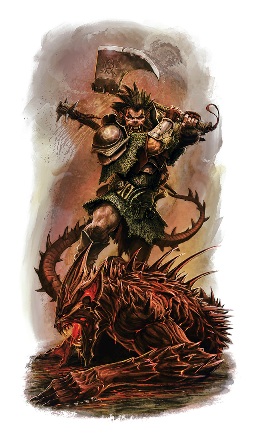
![]() In 2006, Tome of Battle: The Book of Nine Swords was released for D&D 3.5e, just two years before the release of D&D 4e. Book of Nine Swords (besides being a true pleasure to read with its fantastic attention to flavor, similar to the recent shift in books like Monster Vault and MM3) basically gave fighter-types a full nine levels worth of “spells” or exotic and complex maneuvers, putting them on par with wizards and clerics – a true paradigm shift in D&D fantasy!
In 2006, Tome of Battle: The Book of Nine Swords was released for D&D 3.5e, just two years before the release of D&D 4e. Book of Nine Swords (besides being a true pleasure to read with its fantastic attention to flavor, similar to the recent shift in books like Monster Vault and MM3) basically gave fighter-types a full nine levels worth of “spells” or exotic and complex maneuvers, putting them on par with wizards and clerics – a true paradigm shift in D&D fantasy!
The idea of giving martial classes all these choices and powers was groundbreaking. From this standpoint alone, Book of Nine Swords was essentially a prelude to 4e – mechanically and thematically. (In fact, D&D 4e’s development had already begun a year prior in 2005.)
In a sidebar within the introduction, the Book of Nine Swords also talked about the ever-expanding and more inclusive definition of the fantasy genre. It was an honest and plausible take – it’s true fantasy continues to evolve to include more than classic swords and sorcery inspired by our mythology, Tolkien, and our history of warfare. And that is indeed a good thing.
While I prefer classic fantasy (originally inspired by tales of Arthurian legend, and later, Conan and the Lord of the Rings), I love that there are many different retellings, angles, and themes that fall under fantasy these days. Book of Nine Swords had a bit of Oriental Adventures feel to it, for example. And Eberron gives us a touch of Indiana Jones-style adventure along with a dash of magical technology via elemental-powered lightning rails. The ever-expanding definition keeps the genre fresh, imaginative, and exciting, truly inspiring peoples’ creativity – in all sorts of media.
There’s an unprecedented amount of sharing, borrowing and innovating in the fantasy genre today, and in television and movies alone, it’s an exciting time. The Lord of the Rings trilogy established some new and lofty heights and standards for the movie industry and fantasy genre. SyFy continues to produce fantasy, science fiction, and shows that blur the line between both. Right now, Sanctuary is my favorite hybrid. And over on HBO, there’s a lot of appropriate excitement over the recent release of the gritty and dark fantasy series, Game of Thrones.
Now some D&D or RPG gamers or fans of the fantasy genre might not like the more classic themes of fantasy, especially as we move more and more decades away from D&D’s conception. Yet, I’ve seen a few people suggest on the Wizards forums that “the people don’t want medieval” thing any longer. Could it be true?
I don’t buy it, and neither should you. D&D is and has been the #1 tabletop RPG for decades for a reason, and while the 4e vision of D&D fantasy is more inclusive (and that’s a good thing), it’s clearly rooted in pseudo-medieval fantasy.
More unusual campaign setting choices does not mean that suddenly no one wants to play pseudo-medieval fantasy – it means some people want more choices and occasional new places to explore. I don’t recall 100 Al-Qadim or 100 Spelljammer products, do you? But there’s no doubt we crossed the line on 100 Greyhawk and Forgotten Realms products many years and editions ago. While Dark Sun and Eberron might not have as much history as those two settings, they certainly have a substantial amount and are growing in popularity in 4e, continuing to carve out their own fantasy niches as well.
And to be clear, rooted does not equal is. It means exactly just that – D&D’s history and core is inspired by our human history of warfare, our world’s mythology, Tolkien and swords and sorcery fiction, and those themes have plenty of representation in every edition, including 4e. And they should – they are instantly recognizable elements of classic fantasy and therefore D&D itself, so they make an excellent foundation on which to continue to expand the definition of what the fantasy genre includes.
So as we continue forward into D&D’s 4th edition age and beyond, remember to take a balanced view of the fantasy genre in D&D: acknowledge fantasy’s classic themes while simultaneously embracing new ones – just like Book of Nine Swords.